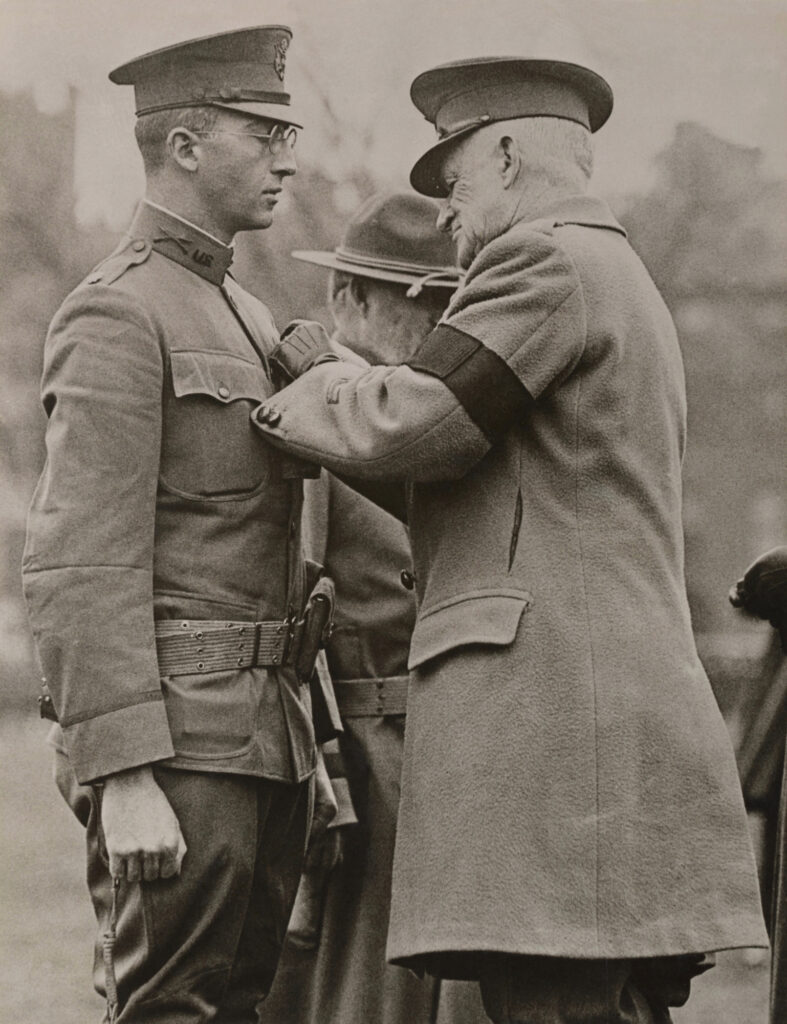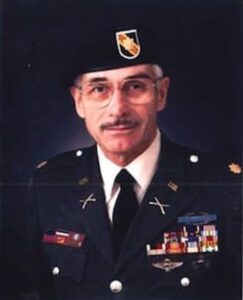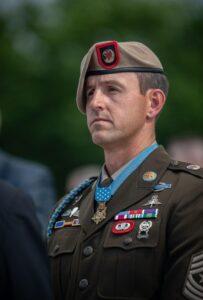- Recipient: Charles Whittlesey
- Branch: U.S. Army
- Combat: World War I
To the casual observer, Lieutenant Colonel Charles Whittlesey seemed destined for a life in academia. He was tall, thin, reserved, and wore thick, “Coke bottle” glasses, which gave him the air of an “affable, extremely reticent, and somewhat professorial sort,” recalled Lieutenant Charles McKeogh, who would later serve under Whittlesey’s military leadership.
Whittlesey attended Williams College in Williamstown, Massachusetts, and actively participated in extracurricular activities, including two student newspapers, the school yearbook, the Delta Psi fraternity, and the Gargoyle Society. Whittlesey was extremely intelligent, a favorite among his peers, and a natural-born leader. Later, these skills would prove useful — and necessary — in an entirely different setting.
In 1908, Whittlesey graduated from Harvard Law School and moved to New York City to work for a private firm. After three years, he left to open a private law practice with his former Williams College classmate and friend, J. Bayard Pruyn.
When America entered World War I in April 1917, Whittlesey willingly signed up to serve in the U.S. Army. He underwent officer training at a military camp in Plattsburg, New York, and graduated in August 1917 as a captain. His quick learning and ability to command a room helped him direct the 77th Division’s 308th Infantry Regiment, nicknamed “The Metropolitan Division” and “The Times Square Division.” The soldiers were primarily immigrants from China, Italy, Ireland, and Eastern Europe. They spoke little to no English and had zero military experience. Yet Whittlesey found a way to connect with them, earning their respect and trust.
After leaving for Europe in April 1918, Whittlesey’s division trained for months before heading into combat for the first time. In August 1918, Whittlesey was promoted to major and directed the 308th Regiment’s 1st Battalion.
One month later, he received orders that changed the trajectory of his life forever.
The “Lost Battalion” Takes the Hill
On October 2, 1918, Whittlesey received orders for an offensive advance in France’s Argonne Forest to capture and hold Hill 198, a strategic high point behind German lines. “All right, I’ll attack, but whether you’ll hear from me again, I don’t know,” he responded. The terrain was thick, dense, and heavily defended by German forces. Whittlesey and his understaffed battalion fought gallantly alongside Captain George McMurtry and a second battalion, advancing through enemy territory in a wild ravine.
That evening, German soldiers surrounded both units, effectively cutting off Whittlesey and his men from food, water, medical supplies, and communication with the Army. This isolation earned them the nickname “the Lost Battalion.”
For five days, Whittlesey led his men into combat, fulfilling orders to advance at all costs. They suffered from constant enemy attacks and unwarranted friendly fire. Whittlesey used his last carrier pigeon, named “Cher Ami,” to send headquarters a frantic message: “Our artillery is dropping a barrage directly on us. For heaven’s sake, stop it.”
On the fourth day of fighting, the enemy scrawled a note to Whittlesey, demanding the battalion surrender. Whittlesey ignored the request and continued to encourage his remaining men. On October 7, 1918, Whittlesey and the Lost Battalion were rescued by American troops. Of the 554 American soldiers in Whittlesey’s unit, only 194 walked away from the battlefield. More than 350 others had been wounded, killed, or had gone missing. Whittlesey refused to leave Argonne Forest until every single wounded comrade had been safely evacuated on October 8, 1918.
For his heroic bravery and fearless leadership, then-Major Charles Whittlesey received the Medal of Honor on December 24, 1918.
A Tragic End to a Hero’s Welcome
Whittlesey had a difficult time re-entering civilian life. He found a place at the Red Cross and outwardly devoted himself to supporting veterans from the Lost Battalion who were dealing with their own challenges. He visited them in hospitals and offered advice when he could. He even attended many of their funerals.
Although the press portrayed Whittlesey as a hero, he downplayed the praise. His quiet nature clashed deeply with reporters who wanted to interview him as the hero of the Lost Battalion. Inwardly, Whittlesey struggled with feelings of guilt and shame for the men who did not come home. Today, many believe he struggled with undiagnosed post-traumatic stress disorder (PTSD).
Whittlesey attended the internment of the Unknown Soldier at Arlington National Cemetery in Washington, D.C., with his friend, Captain George McMurtry, on November 11, 1921. He said, “George, I should not have come here. I cannot help but wonder if that may not be one of my men from the Pocket. I shall have nightmares tonight and hear the wounded screaming once again.”
On November 26, 1921, Whittlesey set sail for Cuba on the S.S. Taloa. Only his housekeeper knew about his travels. He dined with other passengers and participated in conversation in the smoking room. Shortly before midnight, he left for his room. Whittlesey was never seen again. His cause of death was recorded as “drowning at sea by own intent.”
The story of Charles Whittlesey is a harrowing reminder that not all wounds of war are visible. If you or someone you know is struggling and contemplating suicide, help is always available. Get 24/7 support from the Suicide and Crisis Lifeline by simply dialing 988 from any phone.




